
|
|
9 November, 1999
It was a very interesting day in McMurdo. First we found out that the Cape
Roberts drilling had reached 705 meters. That makes CRP-3 the deepest drill
hole into rock ever in Antarctica. Neat to be part of a world record team
even though there have been very few drilling projects on the continent to
date. The drilling goes on, so I will keep you posted as new records are
broken. I also saw two unusual things today; standing water in the streets;
and I spotted two skuas. The weather has been quite warm, close to 30F. The
dark, volcanic cinder streets in town absorb the sunlight making them a bit
warmer creating the puddles. A skua is a large, gull type bird indigenous to
Antarctica. It was quite a surprise to suddenly see birds flying in the sky.
I haven't seen any for quite some time. You just get used to looking out
into a motionless landscape. I am told that the number of skuas will
increase around McMurdo as we go further in to summer. If I get close to one
I will try to get a picture. Until then, if you want to see what a skua
looks like, check out this site:
http://www.mastromedia.com/antarctica/photos/photoant_wildlife_bird_skua.htm
I have been receiving many questions lately. Please keep sending them. I
may not be able to answer them all personally, but the questions give me an
idea of the types of things you are interested in. Several people have asked
me how we get our water in McMurdo. No, we don't melt snow. Although this is
how the early explorers did it and today many of the field camps still do.
Scott Base, the Kiwi Antarctic station, has an old snow melter and some
people around here still remember using it to supply water for the base.
However, with as many as 1200 persons at McMurdo, melting snow would not be
practical. Although over 70 percent of the world's fresh water is in the
Antarctic Ice Sheet, McMurdo and several other bases get their fresh water
from the sea. They have a modern desalination plant that uses a process
called reverse-osmosis (RO) to remove the salt from the seawater. I made a
visit to the desalination plant to see where my drinking water was coming
from. Brett O'Dell, a technician at the plant, showed me around. Water is
pumped into the plant from McMurdo Sound. It is 28F when it enters the plant
(Why doesn't it freeze?). It is warmed up using a heat exchanger. The water
is then filtered through Anthracite coal, sand and gravel and is then
squeezed through a five-micron filter. The water is then pressurized and
forced through long RO units. Reverse osmosis works by forcing the seawater
though a semi-permeable membrane which allows the water to go through, but
does not allow the dissolved solids, like sodium chloride and other salts,
to pass through. So saltwater goes in one end and fresh water comes out the
other end. Smaller RO systems are sometimes used in homes and schools to
produce clean water. The fresh water then has some chemicals added to it.
Carbon dioxide is bubbled through the water to make it slightly acidic (Are
my chemistry students listening? 5O.E. points if you can write the ionic
equation for this process and e-mail it to me.). The increased acidity
allows calcium carbonate that is also added to dissolve in the water. The
ions produced by the calcium carbonate are necessary to make the water less
corrosive to pipes, prevent leaching of metals into the water and improve
the taste. Pure water with nothing dissolved in it tastes pretty bland.
Finally a small amount of chlorine is added to kill any bacteria the water
may have picked up during the processing. The water is stored in 3 large,
54,000 gallon tanks before it is pumped out to the residents of Mactown.
My personal opinion is that the water tastes quite good here and it is
always nice and cold. Speaking of water, I will start the evaporation
experiment tomorrow. I will give you my initial depth readings and then
update you every day or so. The experiment will run about 2 weeks. Again, if
you do not have a copy of the experiment, request one and I will send it.
Today's featured members of the World Record setting CRP-3 Team are
the people responsible for data logging the drill hole. They are Chris
Buecker and Peter Schulze of BGR, a company from Hanover, Germany and Rich
Jarrard of the University of Utah in Salt Lake City. At regular intervals
(the next time will be at about 770 meters) the entire drill string is
removed from the drill hole. It is then that these scientists start their
work. They pass several types of probes down the drill hole to make many
different types of measurements. Some of the things that are measured are:
density, geochemical elements, magnetic properties, temperature, salinity as
well as several other geophysical measurements. This data is then taken back
to Crary Lab where it is processed and compared with the results of the
other scientists to get a more complete picture of the rock that is being
drill.
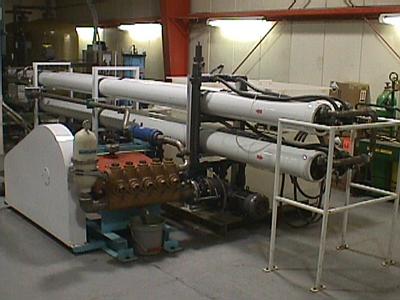
This is one of the RO units used to produce fresh water for Mactown.
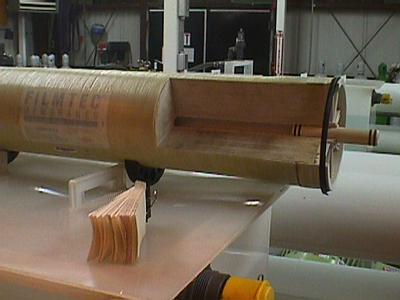
Here is a close up of the RO cartridge showing the semi-permeable membrane. Water is forced from the outside and fresh water comes out of the tube in the middle.
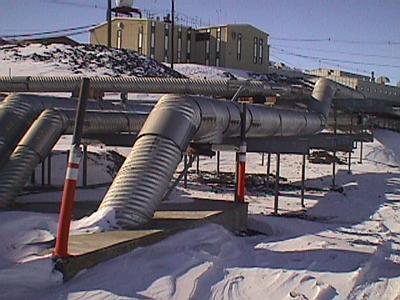
Water is pumped around town in above ground, insulated pipes.
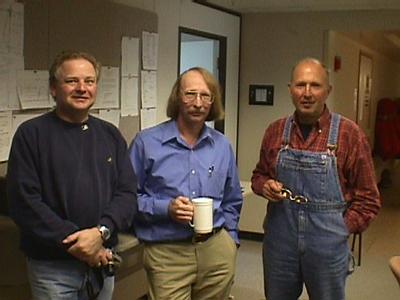
From left to right: Chris Buecker, Rich Jarrard, and Peter Schulze. The down-hole loggers.
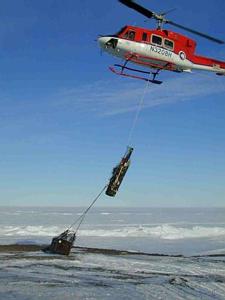
The data logging equipment being transported to the drill site via helo. (This photo comes for the BGR website at http://www.bgr.de/gga/gga_proj/caperob/crp3_helik.jpg.)
Contact the TEA in the field at
.
If you cannot connect through your browser, copy the
TEA's e-mail address in the "To:" line of
your favorite e-mail package.
|
